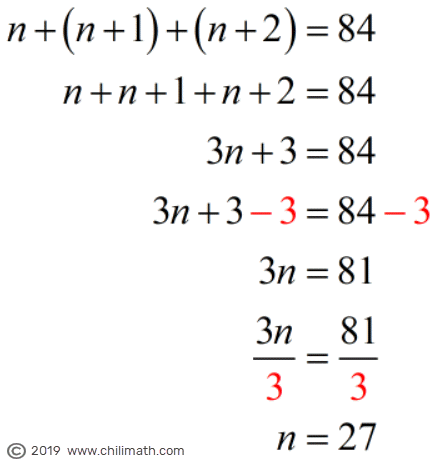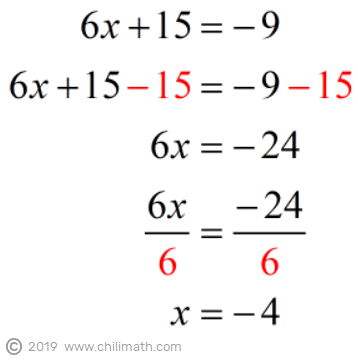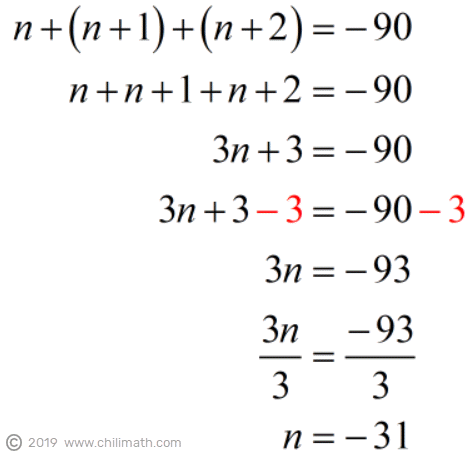Represent Number as Sum of Continuous Integers
Sum of Consecutive Integers Word Problems
When solving word problems involving consecutive integers, it's important to remember that we are looking for integers that are one unit apart.
So if we have n as the first integer, then n + 1 will be the second integer, n + 2 will be the third integer, n + 3 will be the fourth, n + 4 will be the fifth, and so on.

Let's take for example: 15, \left( {15 + 1} \right), \left( {15 + 2} \right), \left( {15 + 3} \right), \left( {15 + 4} \right)
Our results come up to: 15,\,16,\,17,\,18,\,19
When dealing with consecutive integers, notice that the difference between the larger and smaller integers is always equal to 1.
Observe the following:
- \left( {n + 1} \right) - \left( n \right) = n + 1 - n = n - n + 1 = 1
- \left( {n + 2} \right) - \left( {n + 1} \right) = n + 2 - n - 1 = n - n + 2 - 1 = 1
- \left( {n + 3} \right) - \left( {n + 2} \right) = n + 3 - n - 3 = n - n + 3 - 2 = 1
- \left( {n + 4} \right) - \left( {n + 3} \right) = n + 4 - n - 3 = n - n + 4 - 3 = 1
Examples of Solving the Sum of Consecutive Integers
Example 1: The sum of three consecutive integers is 84. Find the three consecutive integers.
The first step to solving word problems is to find out what pieces of information are available to you.
For this problem, the following facts are given:
- We need to ADD three integers that are consecutive
- The numbers are one unit apart from each other
- Each number is one more than the previous number
- The sum of the consecutive integers is 84
With these facts at hand, we can now set up to represent our three consecutive integers.
Let n be our first integer. Therefore,

We're now ready to write our equation. Remember that we are given the sum, so we will be adding our three consecutive integers.

Let's proceed and solve the equation.

Now that we have the value for the variable "n, we can use this to identify the three consecutive integers.

Finally, let's do a quick check to make sure that the sum of the consecutive integers 27, 28, 29 is indeed 84 as given in our original problem.

Example 2: Find four consecutive integers whose sum is 238.
To start, let's go ahead and determine the important facts that are given in this problem.
- We will be adding four successive integers
- The adjacent integers are one unit apart
- The sum of the four consecutive integers is 238
The next step is to represent the four consecutive integers using the variable "n".
Let n be the first integer. Since the four integers are consecutive, this means that the second integer is the first integer increased by 1 or {n + 1}. In the same manner, the third integer can be represented as {n + 2} and the fourth integer as {n + 3}.

We can then translate "the sum of four consecutive integers is 238" into an equation.

Solve the equation:

At this point, the value of n is not our final answer. We will use this value, however, to find the other three integers that follow after n which is 58.

The last condition that we need to satisfy is that the sum of the four consecutive integers must be 238. Obviously, since "sum" means to add, we will be adding the integers 58, 59, 60, and 61.

Example 3: The sum of six consecutive integers is - \,9. What are the integers?
What do we know?
- We will add six consecutive integers
- The sum of the integers is - \,9
- The consecutive integers are one unit apart
- Since the sum of the consecutive integers is a negative number, more likely, the sequence of integers will involve negative integers
Represent the six consecutive integers. This time, we'll use x as our variable.
Let x be the 1st integer.

Next, let's translate "the sum of six consecutive integers is - \,9" into an equation.
x + \left( {x + 1} \right) + \left( {x + 2} \right) + \left( {x + 3} \right) + \left( {x + 4} \right) + \left( {x + 5} \right) = - \,9
Solve:

Now that we know the value of x which is - \,4, let's determine the six consecutive integers.

As you can see, our six consecutive integers are - \,4, - \,3, - \,2, - \,1, 0, and 1. The only thing left for us to do is to check if the sum of the consecutive integers is indeed - \,9.

Example 4: The sum of three consecutive integers is - \,90. What is the largest integer?
This is a type of problem where you need to be careful. Most of the time, we are only asked to find the consecutive integers which when added, must give the specified sum. In this case, however, we not only have to find the three consecutive integers but also determine which among the three integers is the largest. The rule of thumb is to always read the problem carefully and pay close attention to what is asked.
No matter how straightforward a problem is, it's still good practice to always identify what facts are available to you. Think of these pieces of information as your compass showing you directions on how to solve the problem.
What we know:
- We will be adding three integers that are consecutive
- We should get a sum of - \,90 when we add the three integers
- The consecutive or adjacent integers only differ by one unit
- It is likely that we will be dealing with negative integers
Proceed by representing the consecutive integers.
Let \textbf{\textit{n}}, \textbf{\textit{n+1}} and \textbf{\textit{n+2}} be the three consecutive integers.

Now, let's write the equation by translating the math sentence, "the sum of three consecutive integers is - \,90" and solve for n.

Since n = - \,31, then the three consecutive integers are - \,31, - \,30, and - \,29.

Do they total to - \,90 when added? Lets's take a look.

If we're not paying attention, we will usually stop right here because we now have our integers and we got a sum of - \,90 when we added them.
But as you know, we're not done yet! Our problem asked us to identify which among the three consecutive integers: - \,31, - \,30, and - \,29 is the largest.
Therefore, our final answer is - \,29.
You might also be interested in:
Sum of Consecutive Even Integers Word Problems
Sum of Consecutive Odd Integers Word Problems
Source: https://www.chilimath.com/lessons/algebra-word-problems/the-sum-of-consecutive-integers/
0 Response to "Represent Number as Sum of Continuous Integers"
Post a Comment